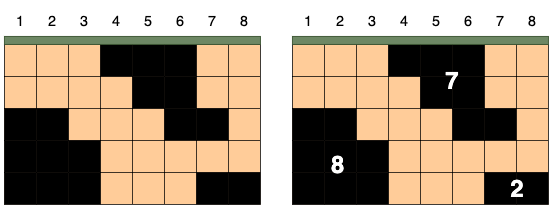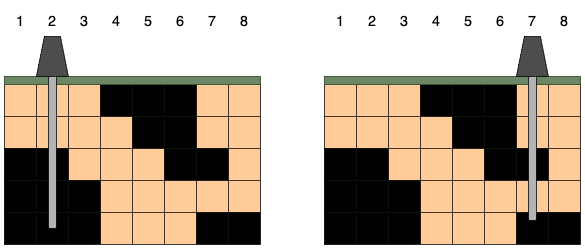LeetCode Problem 739. Daily Temperatures
- Given an array of integers temperatures represents the daily
temperatures, return an arrayanswersuch thatanswer[i]is the number of days you have to wait after theithday to get a warmer temperature.- If there is no future day for which this is possible, keep
answer[i] == 0instead.
- If there is no future day for which this is possible, keep
Examples
-
Example 1:
- Input: temperatures = [73,74,75,71,69,72,76,73]
- Output: [1,1,4,2,1,1,0,0]
-
Example 2:
- Input: temperatures = [30,40,50,60]
- Output: [1,1,1,0]
-
Example 3:
- Input: temperatures = [30,60,90]
- Output: [1,1,0]
Constraints
1 <= temperatures.length <= 10^530 <= temperatures[i] <= 100
Solution
/**
* @param {number[]} temperatures
* @return {number[]}
*/
var dailyTemperatures = function(temperatures) {
const totalLength = temperatures.length;
const answer = new Array(totalLength).fill(0);
const stack = [];
for (let i = 0; i < totalLength; i++) {
while (stack.length && temperatures[stack[stack.length - 1]] < temperatures[i]) {
const index = stack.pop();
answer[index] = i - index;
}
stack.push(i);
}
return answer;
};LeetCode Problem 856. Score of Parentheses
-
Given a balanced parentheses string
s, return the score of the string. -
The score of a balanced parentheses string is based on the following rule:
"()"has score1.ABhas scoreA + B, whereAandBare balanced parentheses strings.(A)has score2 * A, whereAis a balanced parentheses string.
Examples
-
Example 1:
- Input: s = "()"
- Output: 1
-
Example 2:
- Input: s = "(())"
- Output: 2
-
Example 3:
- Input: s = "()()"
- Output: 2
Constraints:
2 <= s.length <= 50sconsists of only'('and')'.sis a balanced parentheses string.
Solution
/**
* @param {string} s
* @return {number}
*/
var scoreOfParentheses = function(s) {
const stack = [0];
const closeParentheses = ')';
for (let i = 0; i < s.length; i++) {
if (s[i] === closeParentheses) {
let last = stack.pop();
last = last === 0 ? 1 : last * 2;
stack[stack.length - 1] += last;
} else {
stack.push(0);
}
}
return stack[stack.length - 1];
};Programmer Problem lev.2 석유 시추
- 세로길이가
n가로길이가m인 격자 모양의 땅 속에서 석유가 발견되었습니다. 석유는 여러 덩어리로 나누어 묻혀있습니다. 당신이 시추관을 수직으로 단 하나만 뚫을 수 있을 때, 가장 많은 석유를 뽑을 수 있는 시추관의 위치를 찾으려고 합니다. 시추관은 열 하나를 관통하는 형태여야 하며, 열과 열 사이에 시추관을 뚫을 수 없습니다.

- 예를 들어 가로가 8, 세로가 5인 격자 모양의 땅 속에 위 그림처럼 석유가 발견되었다고 가정하겠습니다. 상, 하, 좌, 우로 연결된 석유는 하나의 덩어리이며, 석유 덩어리의 크기는 덩어리에 포함된 칸의 수입니다. 그림에서 석유 덩어리의 크기는 왼쪽부터 8, 7, 2입니다.

- 시추관은 위 그림처럼 설치한 위치 아래로 끝까지 뻗어나갑니다. 만약 시추관이 석유 덩어리의 일부를 지나면 해당 덩어리에 속한 모든 석유를 뽑을 수 있습니다. 시추관이 뽑을 수 있는 석유량은 시추관이 지나는 석유 덩어리들의 크기를 모두 합한 값입니다. 시추관을 설치한 위치에 따라 뽑을 수 있는 석유량은 다음과 같습니다.
| 시추관의 위치 | 획득한 덩어리 | 총 석유량 |
|---|---|---|
| 1 | [8] | 8 |
| 2 | [8] | 8 |
| 3 | [8] | 8 |
| 4 | [7] | 7 |
| 5 | [7] | 7 |
| 6 | [7] | 7 |
| 7 | [7, 2] | 9 |
| 8 | [2] | 2 |
-
오른쪽 그림처럼 7번 열에 시추관을 설치하면 크기가 7, 2인 덩어리의 석유를 얻어 뽑을 수 있는 석유량이 9로 가장 많습니다.
-
석유가 묻힌 땅과 석유 덩어리를 나타내는 2차원 정수 배열
land가 매개변수로 주어집니다. 이때 시추관 하나를 설치해 뽑을 수 있는 가장 많은 석유량을 return 하도록 solution 함수를 완성해 주세요.
제한사항
- 1 ≤
land의 길이 = 땅의 세로길이 =n≤ 500 - 1 ≤
land[i]의 길이 = 땅의 가로길이 =m≤ 500land[i][j]는i+1행j+1열 땅의 정보를 나타냅니다.land[i][j]는0또는1입니다.land[i][j]가0이면 빈 땅을,1이면 석유가 있는 땅을 의미합니다.
- 정확성 테스트 케이스 제한사항
- 1 ≤
land의 길이 = 땅의 세로길이 =n≤ 100 - 1 ≤
land[i]의 길이 = 땅의 가로길이 =m≤ 100
- 1 ≤
입출력 예

- 입력 : land = [[1, 0, 1, 0, 1, 1], [1, 0, 1, 0, 0, 0], [1, 0, 1, 0, 0, 1], [1, 0, 0, 1, 0, 0], [1, 0, 0, 1, 0, 1], [1, 0, 0, 0, 0, 0], [1, 1, 1, 1, 1, 1]]
- 출력 : 16
- 설명
- 시추관을 설치한 위치에 따라 뽑을 수 있는 석유는 다음과 같습니다.
| 시추관의 위치 | 획득한 덩어리 | 총 석유량 |
|---|---|---|
| 1 | [12] | 12 |
| 2 | [12] | 12 |
| 3 | [3, 12] | 15 |
| 4 | [2, 12] | 14 |
| 5 | [2, 12] | 14 |
| 6 | [2, 1, 1, 12] | 16 |
- 6번 열에 시추관을 설치하면 크기가 2, 1, 1, 12인 덩어리의 석유를 얻어 뽑을 수 있는 석유량이 16으로 가장 많습니다. 따라서 16을 return 해야 합니다.
Solution
function solution(land) {
const n = land.length;
const m = land[0].length;
const visited= new Array(n).fill().map(_ => new Array(m).fill(0));
const oilMap = new Map();
let maxOil = 0;
let oilIndex = 1;
const dx = [-1, 0, 1, 0];
const dy = [0, 1, 0, -1];
function bfs(rowIndex, colIndex) {
const queue = [[rowIndex, colIndex]];
let oilCount = 0;
visited[rowIndex][colIndex] = oilIndex;
while(queue.length) {
const [x, y] = queue.shift();
if (land[x][y]) {
oilCount++;
}
for (let i=0; i<4; i++) {
let nx = x + dx[i];
let ny = y + dy[i];
if (nx < 0 || nx >= n || ny < 0 || ny >= m || visited[nx][ny]) continue;
if (land[nx][ny]) {
visited[nx][ny] = oilIndex;
queue.push([nx, ny]);
}
}
}
oilMap.set(oilIndex, oilCount);
oilIndex++;
return oilCount;
}
for (let i = 0; i < n; i++) {
for (let j = 0; j < m; j++) {
if (! visited[i][j]&& land[i][j]) {
bfs(i, j);
}
}
}
for (let colIndex = 0; colIndex < m; colIndex++) {
let oilSum = 0;
const oilIndexSet = new Set();
for(let rowIndex = 0; rowIndex < n; rowIndex++) {
const oilIndex = visited[rowIndex][colIndex];
if (oilIndex) {
if (!oilIndexSet.has(oilIndex)) {
oilSum += oilMap.get(oilIndex);
}
oilIndexSet.add(oilIndex);
}
}
maxOil = Math.max(maxOil, oilSum);
}
return maxOil
}